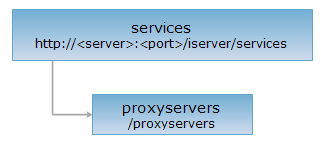<services_uri>/proxyservers[.<format>]
Gets the list of the proxy iExpress for iServer service. About the service proxy, please see service proxy. The different client segments will get the corresponding iExpress list based on the configuration by using the function network segment settings from iServer. Gets all iExpress list of proxy service if the function isn't used.
Supported Methods:
Supported output formats: RJSON, JSON, XML.

Implement the HTTP request on the following URI, where supermapiserver is the server name, with rjson being the output format.
http://supermapiserver:8090/iserver/services/proxyservers.rjson
Gets the list of the proxy iExpress for iServer service.
There is a descriptive collection of proxy server iExpress in the entity of response messaging, where the structure of a single proxy server description is as follows:
| Field | Type | Description |
| address | String | The iExpress address of proxy local server. |
| aliases | String | iExpress alias. Used for iExpress proxy services to facilitate master node identification. |
| weight | int | The weight value of the iExpress. |
The returned rjson format representation after implementing the GET request on the proxyservers resource: http://localhost:8090/iserver/services/proxyservers.rjson is as follows:
[{
"ddress": "192.168.17.116:8091",
"liases": "",
"weight": 1
}]
Asks for the response identical to the one that would correspond to a GET request, but without the response body. This is useful for retrieving meta-information written in response headers, without having to transport the entire content. The meta-information includes the media-type, content-encoding, transfer-encoding, content-length, etc.
HEAD request can be used to check if the proxyservers resource exists, or if the proxyservers resource can be accessed by clients. It can also determine if the proxyservers resource supports an output format <format> if performed on a URI with <format> included.